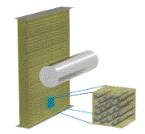Mechanical and Materials Engineering, Department of

Department of Engineering Mechanics: Dissertations, Theses, and Student Research
Date of this Version
Summer 7-2012
Document Type
Thesis
Abstract
The propagation of ultrasound through complex biological media, such as the human calvarium, poses a great challenge for modern medicine. Several ultrasonic techniques commonly used for treatment and diagnosis in most of the human body are still difficult to apply to the human brain, in part, because of the properties of the skull. Moreover, an understanding of the biomechanics of transcranial ultrasound may provide needed insight into the problem of blast wave induced traumatic brain injury (TBI). In the present study, the spatial variability of ultrasonic properties was evaluated for relevant frequencies of 0.5, 1, and 2.25 MHz. A total of eighteen specimens from four donors were tested using a through‐transmission configuration. With the aid of a two interface model, the ultrasonic attenuation coefficient was determined from the total energy loss at various locations on the specimens. With the same setup, speed of sound through the bone layer at the same locations was also determined. Mean volumetric densities at various locations on the samples were determined from computed tomography images. The results show good correlation between attenuation and volumetric density, particularly for the higher frequencies. In addition, the spatial variability of the attenuation, within a single person and with respect to different people, was found to be much larger than expected. These results are anticipated to have a major impact on transcranial biomedical research.
Adviser: Joseph A. Turner
Included in
Biomaterials Commons, Engineering Mechanics Commons, Engineering Physics Commons, Mechanical Engineering Commons, Mechanics of Materials Commons


Comments
A thesis Presented to the Faculty of The Graduate College at the University of Nebraska In Partial Fulfillment of Requirements For the Degree of Master of Science, Major: Engineering Mechanics, Under the Supervision of Professor Joseph A. Turner. Lincoln, Nebraska: July, 2012
Copyright (c) 2012 Armando Garcia Noguera